The Swedish melodic death metal pioneers continue solidifying their reign as technical titans. That’s due in part to signature guitars—Epiphone Les Paul Customs plus Jackson Diabolics and Soloists that rip and roar—as well as Zon Sonus basses. Altogether, these steely vets with thundering tenacity are feeling the surge of fresh sonic blood.
If In Flames didn’t invent melodic death metal, they cemented the genre’s arrival with Lunar Strain and Subterranean, and if those were early blueprints to the burgeoning style, the Swedes’ The Jester Race and Whoracle were the impeccable benchmarks that made the aggressive artform matter. They’ve continued to push the genre forward with ten subsequent releases—including 2023’s raw, visceral Foregone—further strengthening their core sound that, at its heart, is a modernized blend of intensified Iron Maiden and accelerated Black Sabbath.
Before the band’s headlining show at Nashville’s Marathon Music Works, In Flames’ Björn Gelotte, Chris Broderick, and Liam Wilson welcomed PG’s Perry Bean for a conversation about their powerful setups. Gelotte detailed his workingman’s signature Epiphone Les Paul Custom before his tech Greg Winn showcased a pair of unknown Marshall prototype amps never featured on a Rundown. Shredmeister general Chris Broderick discussed his hands-on approach to designing his signature sound that includes a beveled Jackson Diabolic CB2, modified DiMarzio humbuckers, and a thumbpick he invented. Lastly, Wilson compared the requirements and difficulties between playing bass with Dillinger Escape Plan and In Flames before dissecting his morphing setup that’s trying to feel like home while honoring Peter Iwers’ and Bryce Paul’s thunderous footsteps.
Brought to you by D’AddarioB.I.G.
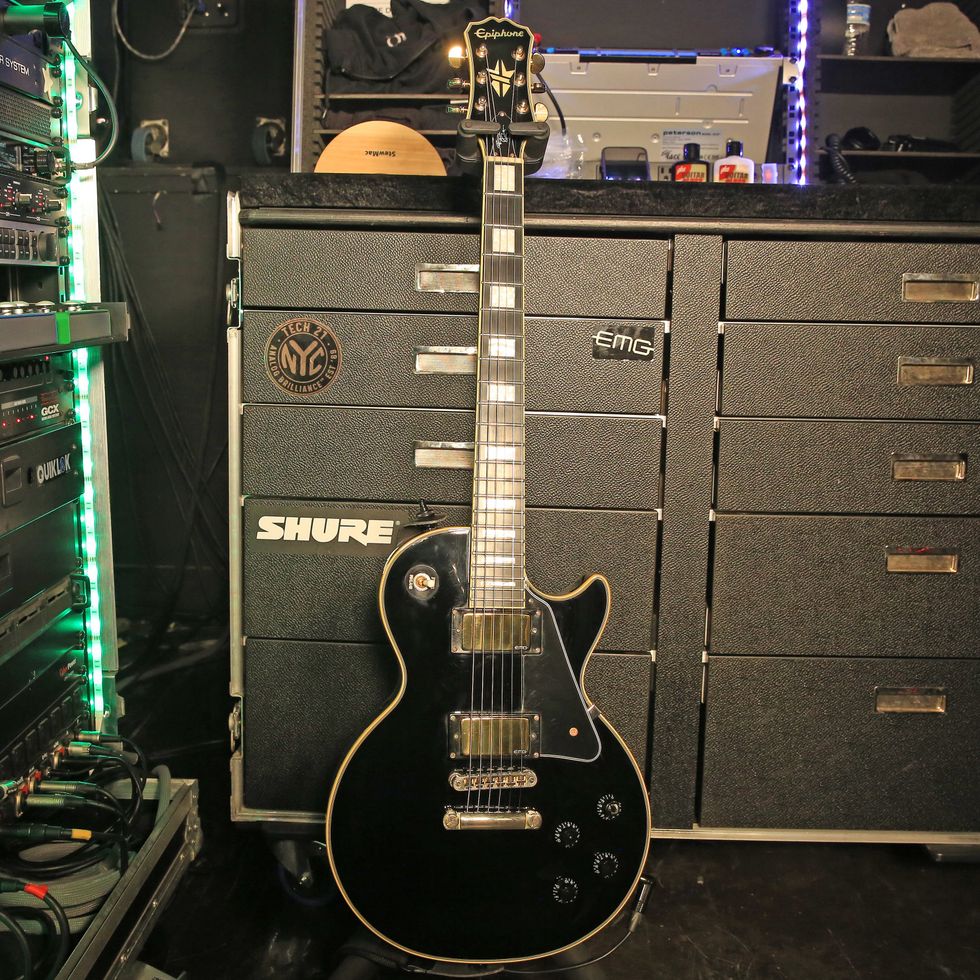
Björn Ingvar Gelotte used his favorite Gibson Les Paul Custom so much he beat it into submission. It was a special instrument that he wore down to retirement because of fear of ruining it beyond repair. Luckily, around that same time, Gibson called the Swedish shredder wanting to collaborate on a signature model, but being a man of the people, he opted for an Epiphone namesake to keep the price down for fans and aspiring guitarists. It has a mahogany body and neck, an ebony fretboard, a LockTone “Nashville-style” Tune-o-matic bridge, Grover tuners, and a set of high-voltage EMG 81/85 MetalWorks active pickups finished in gold. Both of his guitars take a custom configuration of Dunlop strings (.012-.016-.022-.038-.052-.068) and they either ride in C or A# tunings.
Have a Drink on Me
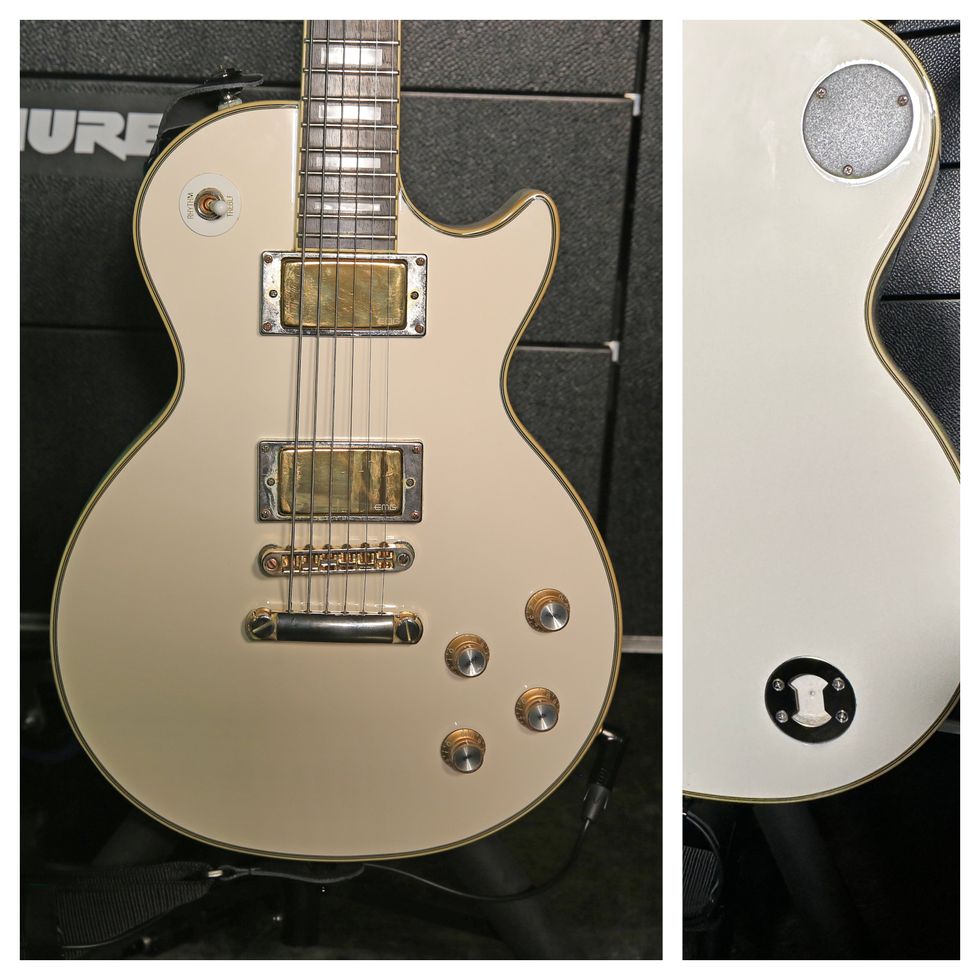
This is Björn’s second signature Epiphone Les Paul Custom finished in bone white. It has the same DNA as the midnight ebony slugger, but it has gold “top hat” knobs and a stainless-steel bottle opener on its backside.
Mystery Machine
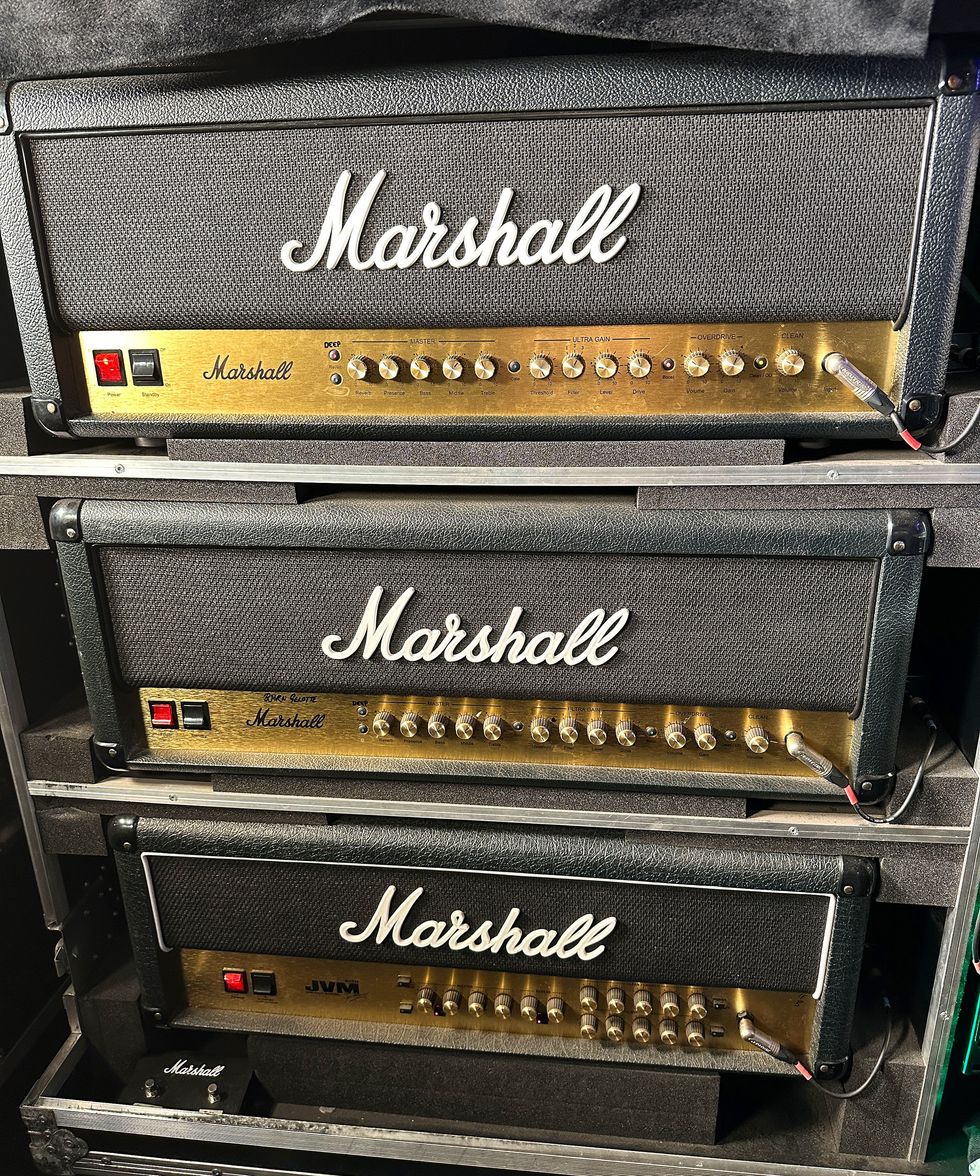
Gelotte has trusted his live tone to tenured tech Greg Winn for many years. Winn has encountered many growlers, but to his ears, nothing purrs like these rare Marshall MD61 heads (top and middle). He notes during the Rundown that they use four EL34 power tubes and four ECC83 preamp tubes. These are not production amps and Winn believes that less than 20 prototypes were built. They use JVM-series parts but have unique sonic architecture in their wiring. The top and middle MD61s are Björn’s clean and dirty amps, and because they’re a scarce commodity, they travel with a third Marshall (JVM205H) for backup purposes.
Can't You Hear Me Rocking?

In Flames has a clean, quiet stage. The MD61s hit an iso cab offstage that houses a single Celestion Vintage 30, which is miked by a couple of sE Electronics Voodoo VR1 passive ribbon mics.
Björn Gelotte's Pedalboard
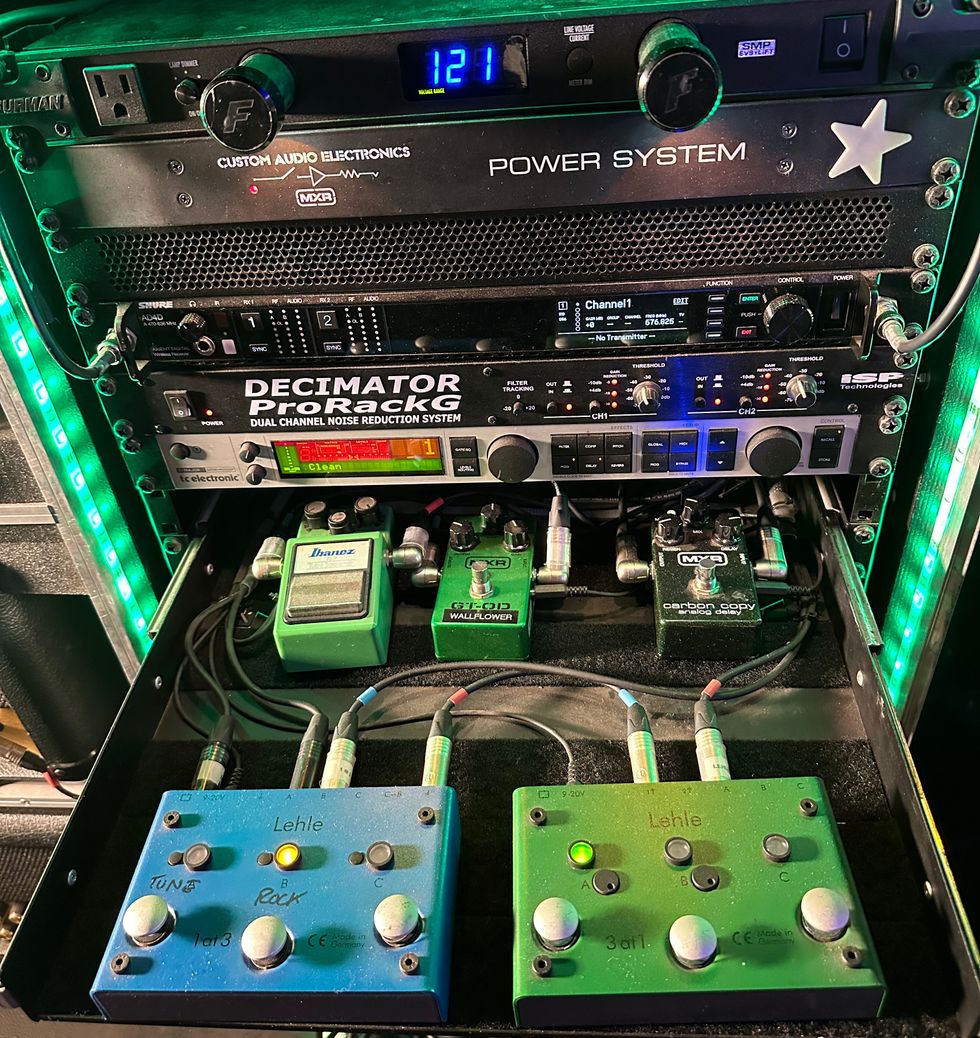
A Les Paul Custom and Marshall don’t need much help to sound great when playing metal, but to add some spice and space, Gelotte will engage an Ibanez TS9 Tube Screamer or MXR M193 GT-OD Overdrive for extra gain, and a MXR Carbon Copy delay for leads. Any additional effects come from the rackmount TC Electronic G-Major 2. To keep everything tight and crisp, Gelotte hits an ISP Technologies Decimator Pro Rack G. He plugs his guitars into a Shure AD4D wireless system and a couple Lehle boxes—1at3 SGoS and 3at1 SGoS instrument switchers—to organize signal flow and work with a Voodoo Lab Ground Control Pro MIDI foot controller.
Beveled Beauty
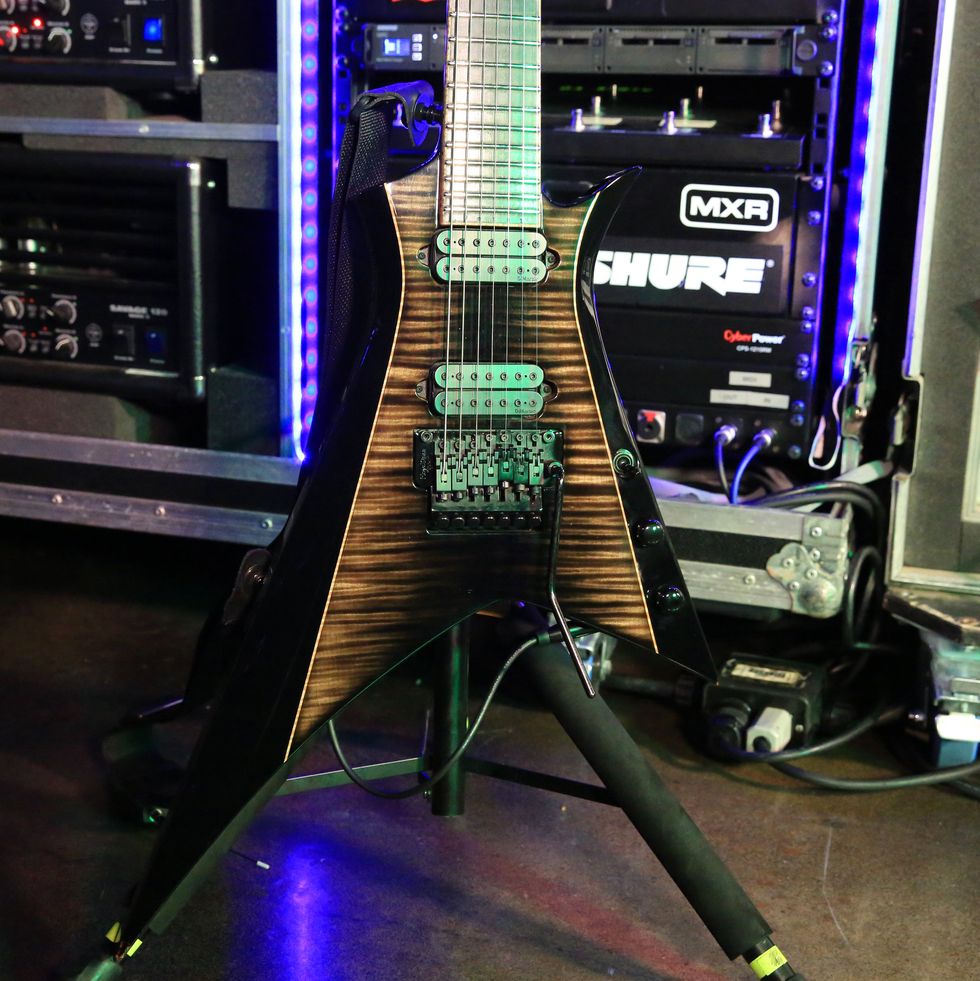
Chris Broderick has toured with In Flames since 2019. He officially became a part of their crew in 2022 and made his studio debut with the band on 2023’s Foregone. Onstage he’s been getting the job done on a 4-pack of devilish 7-string instruments. Here’s his Jackson USA Custom Shop Chris Broderick Diabolic CB2 that is made with a mahogany body topped with a flame-maple cap, a quartersawn maple neck-through-body that has graphite reinforcement, an ebony fretboard, a recessed Floyd Rose Pro 7 bridge, D’Addario Auto-Trim tuners, and direct-mounted, custom-voiced DiMarzio humbuckers that are tweaked versions of their D Activator (bridge) and PAF Pro (neck). It’s worth noting the push-pull tone knob, when in the pull position, engages the tone circuit, whereas when pushed down, it bypasses it.
White Walker
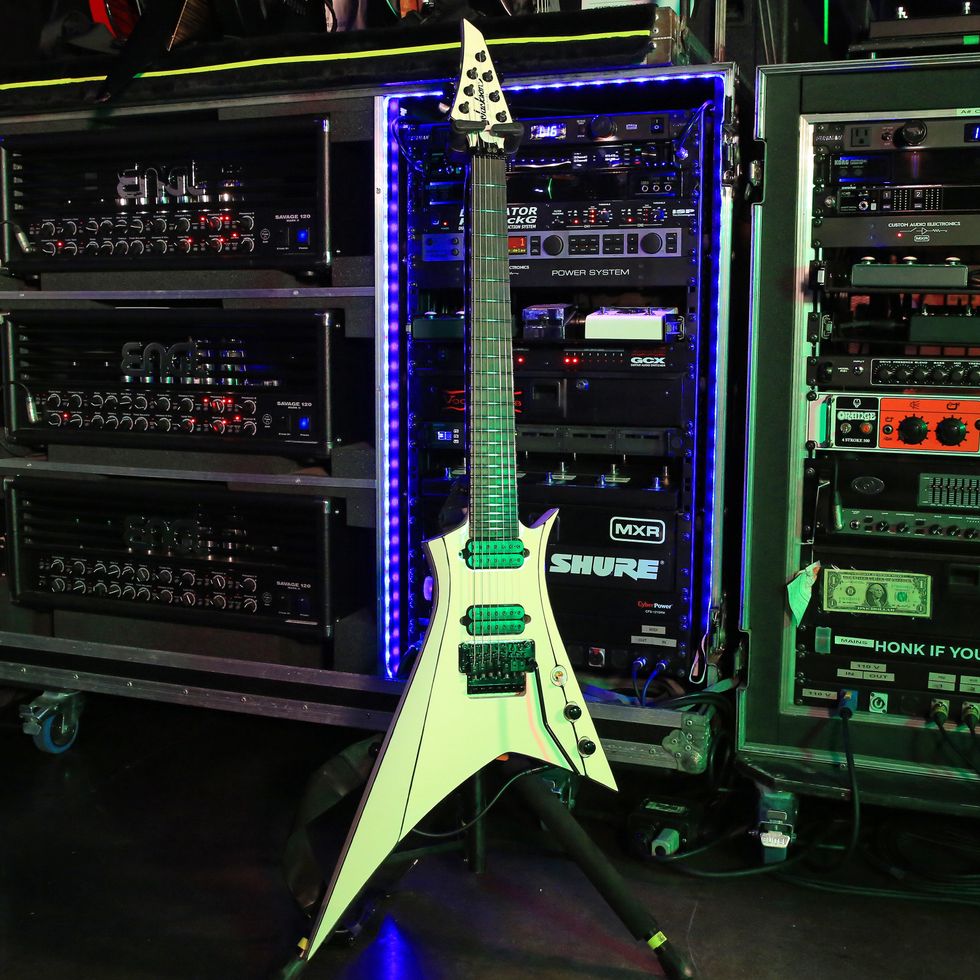
This slick ride was the first-ever prototype for Broderick’s Diabolic signature line. He dug it so much that only minor changes were requested: moving the neck deeper into the body pocket for a tighter silhouette and slightly moving the controls out of his way, otherwise the Jackson Custom Shop knocked it out of the park
Flamethrower
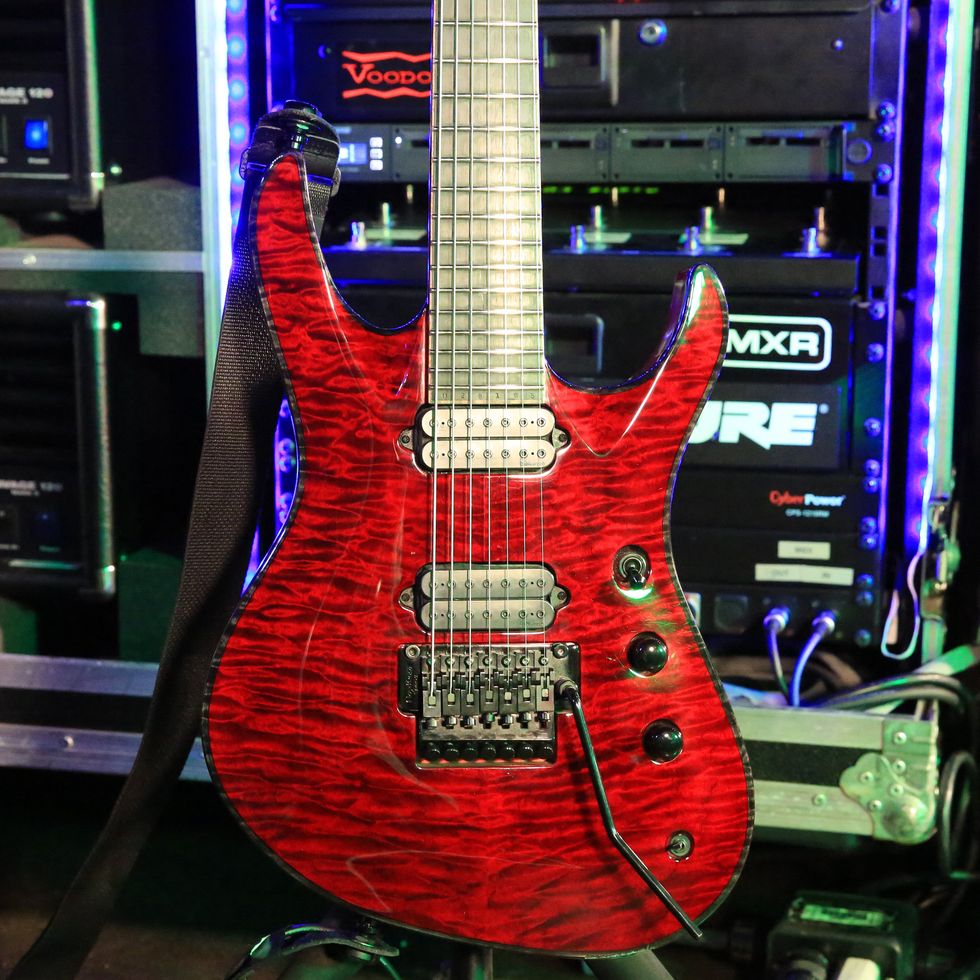
After the success of partnering with Jackson on the Diabolic CB2, Broderick wanted to create something more subdued and built off the company’s Soloist platform. The Jackson USA Signature Chris Broderick Soloist 7 includes many of the same ingredients—mahogany body, maple neck, ebony fretboard, Floyd Rose Pro 7 bridge, and custom-voiced DiMarzio humbuckers—from the CB2 but some differences include a coil-split option with a push-pull master volume, a quilted maple top, a set-neck construction, and a kill switch.
Broad Strokes
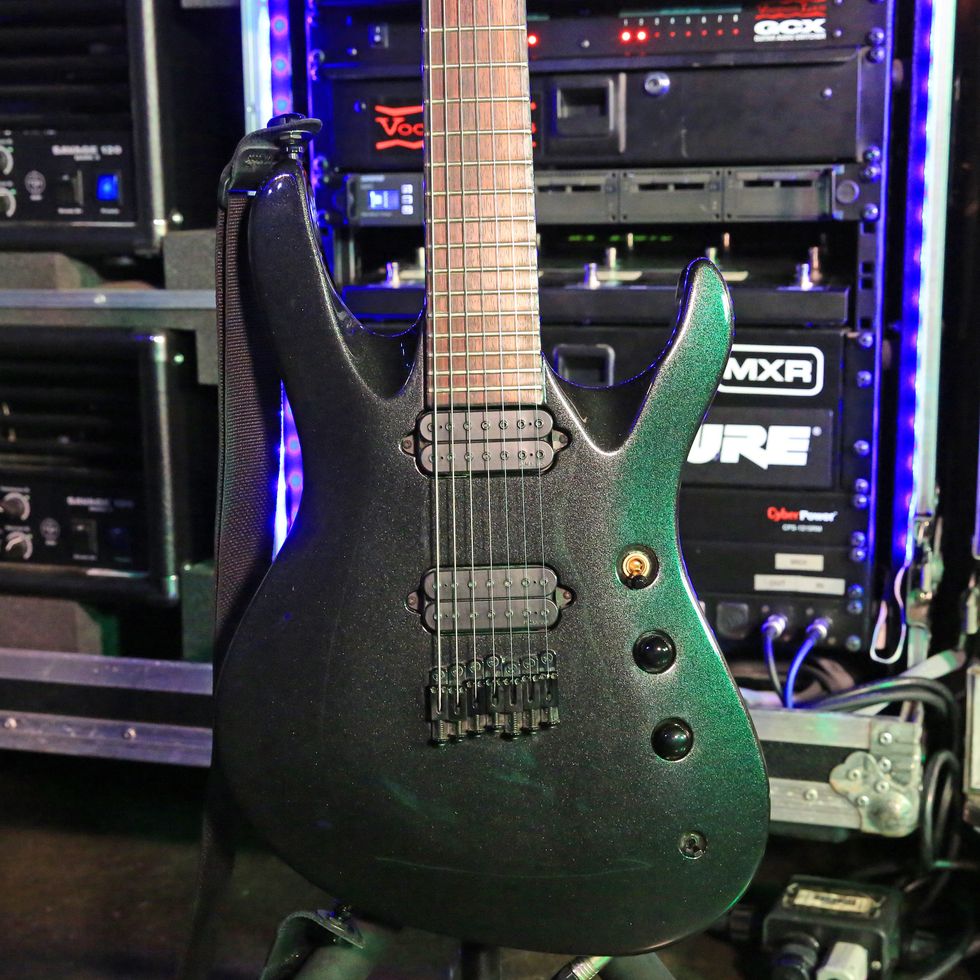
Proving not only the quality of the Jackson Pro series, but also that a talented painter can use any brush to make art, he also tours with his import Jackson Pro Series Chris Broderick Signature HT7 Soloist that has a mahogany body, maple neck, laurel fretboard, Jackson hardware, and Broderick’s custom-voiced DiMarzio humbuckers. Like the Soloist, it includes the master volume push/pull option for coil-splitting, the tone circuit can be removed (when pushed down), and a kill switch.
Excalibur
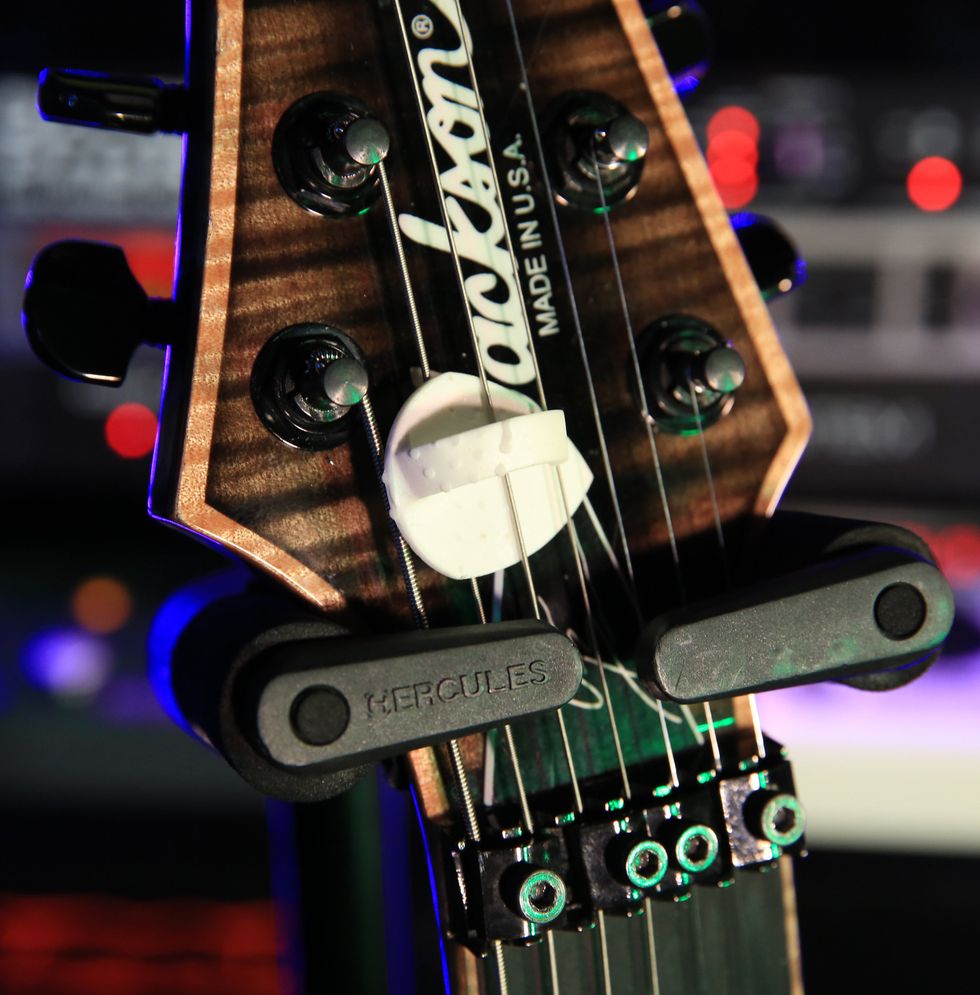
Broderick has tried finding the pick for years. He finally found the perfect plectrum … he only had to design and make it himself via a CAD program and 3-D printer. As you can see, it’s a wide, rounded thumb pick that has a short tip for fluidity and precision. And all his guitars take Ernie Ball 7-String Super Slinkys (.009-.052).
Eviscerators

Chris matches Björn’s ferocity with a dual-amp setup, too. His weapon of choice, however, is the 4-channel Engl Savage 100. Each head motors up to 120W and rumbles off a pair of 6550 tubes. He runs a clean-and-dirty setup with the two Engls and has a third Savage as a backup. Unlike Gelotte, Broderick runs his amps into a full 4x12 (ENGL Amplifiers E412VGB 240W cab with Celestion Vintage 30s) that’s out of view on the side of the stage.
Chris Broderick Pedalboard
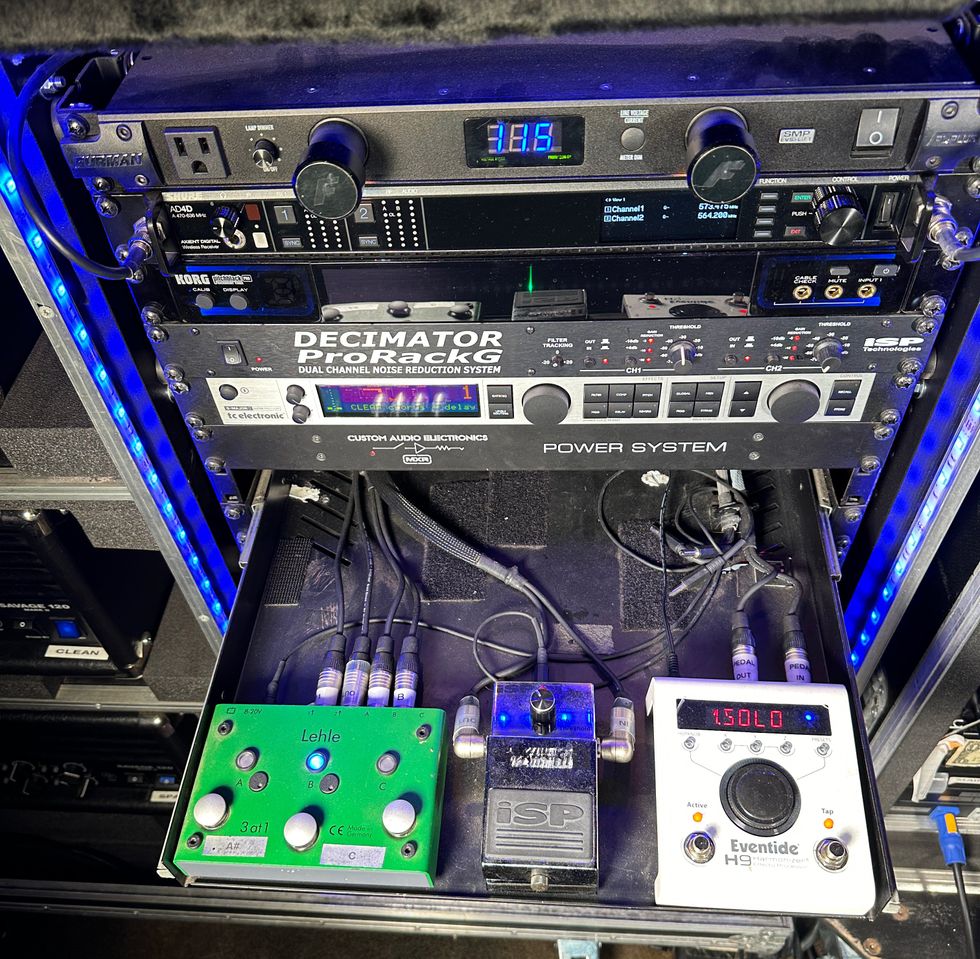
Keeping things tidy onstage, everything changing Broderick’s tone resides offstage in a rack. Signal from the guitar starts with the Shure AD4D wireless system, an ISP Technologies Decimator Pro Rack G keeps down the noise—with an ISP Technologies Decimator II G-String for extra coverage—and a TC Electronic G-Major 2 and Eventide H9 do the heavy coloring. And a Lehle 3at1 SGoS instrument switcher handles guitar changes.
Tone Zon
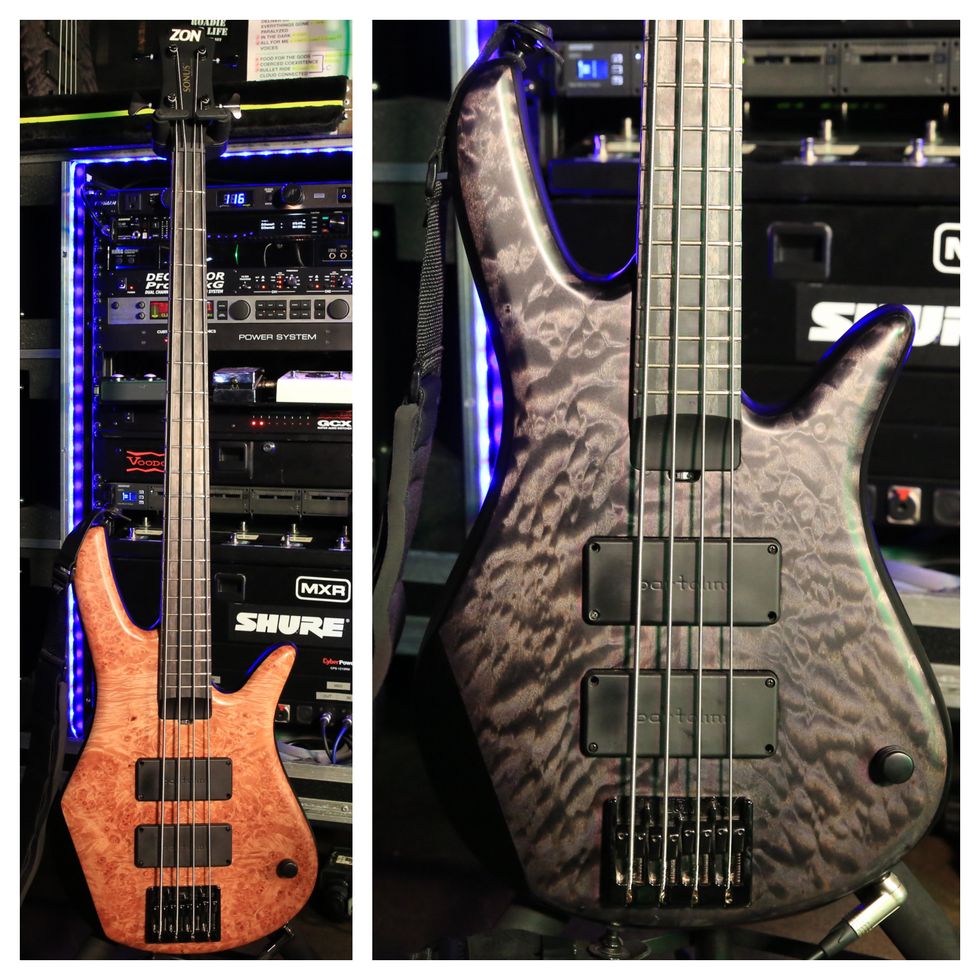
Bassist Liam Wilson spent the last 20 years holding down the chaos for Dillinger Escape Plan. He joined In Flames last year and helping him seamlessly make the transition is a pair of longtime 4-string companions. They are Zon Sonus Special 4 models that both have a 35" scale length, ash body with a maple top—black is flame and brown is burl—composite neck and fretboard, and specially-wound Bartolini “multi-coil” active pickups that give the basses amazing clarity and punch. With Dillinger, he used picks, but for In Flames material, he exclusively plays fingerstyle. He goes with a custom set of Ernie Ball strings (.070-.090-.110-.135).
Here's what Liam said on a recent social media post about the instruments: “Absolute masterpieces. I appreciate all the time you spent to keep the dialogue going and deliver EXACTLY what me and the In Flames crew needed. Your commitment to the craft is inspiring. Endless thanks for digging so deep to get these to me in time, at the craziest time of the year, I’ve never felt so in my power as I do playing these instruments…Next level stuff!”Jab! Cross! Uppercut!
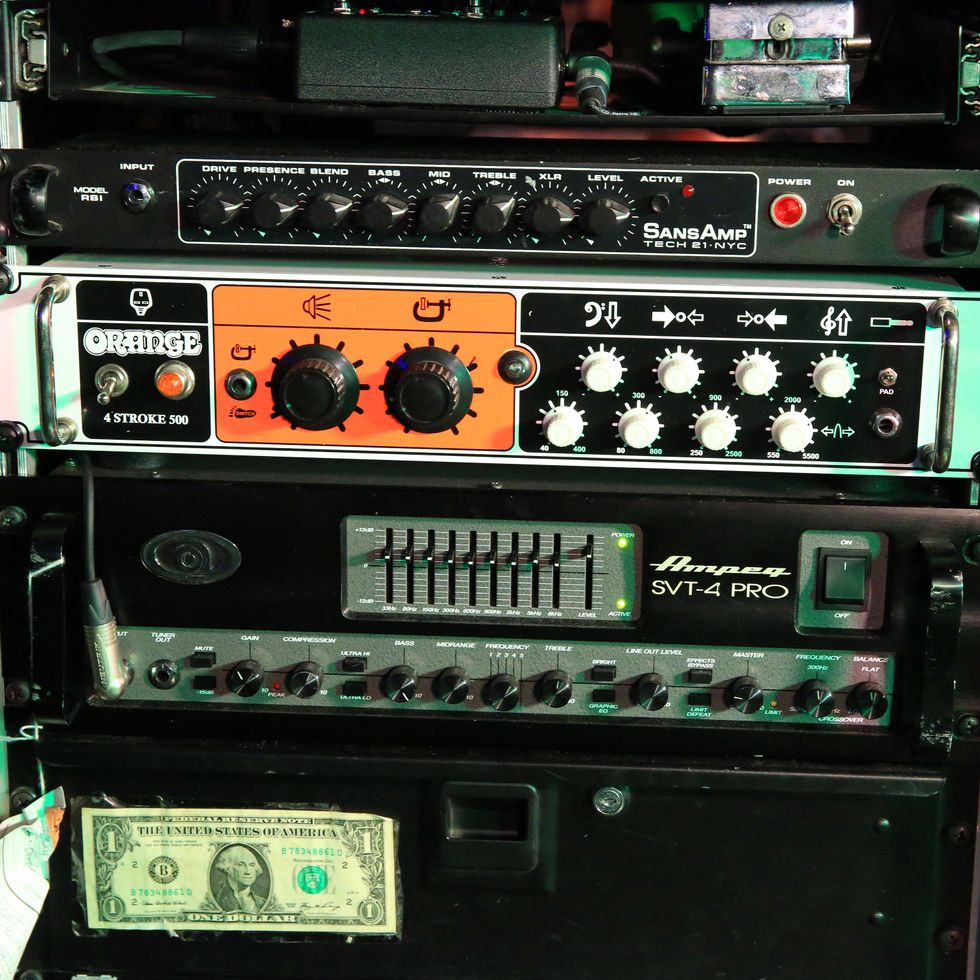
Prior to In Flames, Liam has always used a variation of an Ampeg SVT. He replaced Bryce Paul, who was an Orange dude, so Wilson has been trying several combinations of amps and pedals to nail the band’s evolving bass tones from their 14-album lineage. At the Nashville stop, Wilson was putting his Sonuses through these clobber boxes—a Tech 21 SansAmp RBI bass preamp, an Orange 4 Stroke 500, and an Ampeg SVT-4 Pro.
Shop In Flames' Rig

EMG 81 MetalWorks Gold
Jackson USA Signature Chris Broderick Soloist 7
Jackson Pro Series Chris Broderick Signature HT7 Soloist
MXR GT OD
MXR Carbon Copy
Ibanez TS9 Tube Screamer
EMG 85 MetalWorks Gold
Shure AD4D
sE Electronics Voodoo VR1 Passive Ribbon Mic
ISP Technologies Decimator Pro Rack G
Lehle 1at3 SGoS 3 Amp Switcher Pedal
Lehle 3at1 SGoS Instrument Switcher
Voodoo Lab Ground Control Pro MIDI Foot Controller
Ernie Ball 7-String Super Slinkys (.009-.052)
ENGL Amplifiers E412VGB 240W Cab
Eventide H9
ISP Technologies Decimator II G-String
Tech 21 SansAmp RBI Bass Preamp
Ampeg SVT-4PRO 1200-watt Tube Preamp Bass Head




![Devon Eisenbarger [Katy Perry] Rig Rundown](https://www.premierguitar.com/media-library/youtube.jpg?id=61774583&width=1245&height=700&quality=70&coordinates=0%2C0%2C0%2C0)























































